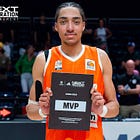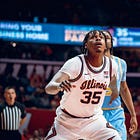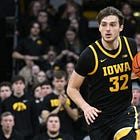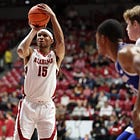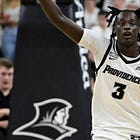Mailbag Q&A - Part II
Here it is! The second mailbag! This is the place where I answer the questions that arose from the NBA Draft subreddit. As always, I try to go into detail as much as I can. Enjoy!
Before we start, please consider subscribing. The newsletter passed the milestone of 500 subscribers! Join a group of NBA decision-makers, NBA scouts, agents, and countless draft and basketball fanatics who made this newsletter the go-to for quality, in-depth scouting reports on the less-heralded prospects. That is my M.O. and promise.
As a limited-time offer, I am giving a discount of 25% for life, which makes it less than three bucks a month for lots of in-depth scouting reports and other various types of content I am working on. So far, My track record has over 300K+ words written on more than 80 scouting reports for the 2024 NBA Draft. I am going to write more than 100 for this year’s class!
Introduction
After a successful first version, here’s the second Mailbag of this draft cycle! Yet again, I have received great questions I will answer in detail. I couldn’t make this an audio record, but that’s one of the goals I am working toward for the near future.
A special thank you to the people of the NBA Draft subreddit, specifically CourtVizion, NOT_H1M, Hareeb_Alzak, Waste-Bath4492, and jubafft for sending in excellent questions which I have the honor to answer today.
Let’s get started!
Questions
NOT_H1M: Why is Noa Essengue consistently mocked so high on boards? His jumper is cooked.
I wrote an in-depth scouting report earlier in the cycle, where I emphasized his physical tools, traits, and projected role. It’s not what he does today, but what he will do for an NBA team in the future. I say this because if you look at the physical development, he has grown quite a few inches over the last few years. His frame was slow to keep up with the growth of his body. That’s causing the natural need to adjust to his new body.
He indeed has to improve in some areas, with his shooting mechanics of his jumper being one of the primary areas of development. On top of that, at times he doesn’t look to have the confidence while having a habit of overhelping on defense. But experiences against older players and more reps are what will make improvement imminent.
However, he’s not highly touted by NBA front-office personnel for his shooting ability or what his defense is today. He can develop into a primary ball-handler and creator as a plus-sized wing, which has become the most valuable archetype every team is trying to discover via the draft.
The factor that puts him in lottery contention is that Essengue projects to be a scalable wing. He doesn’t have to have the ball in his hands to impact the game. Thus scaling up from a reduced role to be a solid starter is the developmental path that Essengue—in the best possible scenario—will follow.
The next question is a combination of both:
Hareeb_Alzak: Can you do a top 5 sophomore list? I'm interested to see your thoughts on CMB, Jarin Stevenson, etc.
CourtVizion: For all the hype on the freshmen coming in, who is your favorite prospect from last year's draft who decided to stay in school one more year?
Here are my top six, as ranked on my previous Big Board 1.0:
Amani Hansberry (PF/C, 6’8”/240) from West Virginia
Collin Murray-Boyles (PF, 6’7”/245) from South Carolina
Owen Freeman (C, 6’10”/230) from Iowa
DeShawn Harris-Smith (SG, 6’5”/210) from Maryland
Jarin Stevenson (PF, 6’10”/195) from Alabama
Garwey Dual (PG, 6’5”/195) from Seton Hall
CourtVizion: As a Wizards fan, I'm curious about your opinion about which prospect may best fit the team's current situation. Let's assume they don't get the #1 pick to make it more fun since Flagg would be an easy choice. Why would you pick the prospect you did?
I love this question. The Wizards made it clear that they still have the slot for the future number-one guy wide-open. Alex Sarr will be a utility piece, with high-end defensive qualities to solidify his status as a starter. I see Bilal Coulibaly having a better chance of becoming a third-fourth option in terms of the scoring load. He’ll be a solid rotational piece as a complementary player to the team’s star. Drafting Carlton Carrington improved the Wizards’ need for offensive creativity. He should play himself to being a top-8 guy in the future version of the Wizards that’s ready to contend for a title.
Looking at this year’s and next year’s class, there’s a realistic chance Washington can get Cooper Flagg, Cameron Boozer, or AJ Dybantsa. Of all names, I am the highest on Dybantsa, who’s ready to score over 15 in college today, let alone what he’ll be next year or in his rookie year in the NBA. They must find their future cornerstone in the 2025 or 2026 class.
If they don’t get Flagg, I would focus on acquiring Ace Bailey. That’s purely based on today’s big-media rankings. My favorite player for the Wizards around that late- or post-lottery status is Kanon Catchings. For their top-five selection, I would go for the best player available, and figure things out later. That leaves me leaning toward Bailey, who has the highest potential of them all but needs to show that he can play in a system at Rutgers. If he doesn’t stand out in that regard, I would settle for VJ Edgecombe and add more offensive scoring power to the guard positions. Keeping Poole and Brogdon would make it more difficult, but I am banking on one of them being traded in this scenario.
jubafft: Can you do NBA player comps for the top 20 prospects?
I won’t go for all of my guys in the top 20. But I made a selection of five names where I compare their future NBA role and trajectory on top of the playing style.
Nolan Traore: I am in no way comparing them for the potential outcome. But Traore gives serious young Kyrie Irving vibes. The aspects of his extremely tight handles, and angle-creation via both speed and deception while thriving as an interior scorer give Traore a fantastic outcome if he hits in the 100th %ILE of his raw potential.
Khaman Maluach: He’s this generation’s version of Tyson Chandler. To succeed in running four- and five-out schemes, it starts with having a fantastic anchor in the middle, who can be the fifth player on the perimeter. In Chandler’s era, the playing style was different. But what brings them in the same style is the combination of footwork, agility, and quickness on top of the size and length. If Maluach gets stronger in the next few years, he can slowly become the powerful rim protector and deterrent Chandler was in his prime, winning Defensive Player of the Year while playing for New York.
V.J. Edgecombe: I see the late Indiana Pacers version of Victor Oladipo. The combination of aggressiveness, elite speed, and quickness is on top of a great scoring arsenal, especially inside the arc. That series against the Cavaliers in 2018, which Cleveland won in seven games, was one of my favorite playoff battles I have fully watched. Edgecombe plays like Oladipo in that context with his advantage-creation and rim pressure being the base. His decision-making as an aggressive scorer, while impacting the game away from the ball with his floor-spacing, physicality, and shooting off the catch is what Edgecombe’s role will be at the next level—the flair of a team’s number one, while easily scaling down to a reduced role when needed.
Drake Powell: He’s one of my favorite future complementary pieces in this draft. What I like about Powell is that he’ll play in a similar role at North Carolina, where he can earn the needed on-ball reps to solidify his status as a wing scorer. His incredibly long arms, strong body, and skillset give him the ability to impact the game on both ends. In the NBA, I see him playing a role similar to Robert Covington, with the modern NBA touch being the long-term potential as a scorer. The fun part here is that Covington was a very productive college player, but had to reduce his role once he arrived in Philadelphia. I foresee the other way around for Powell, where he will gradually earn a bigger role in the NBA, but stick to his role as a key complementary piece.
Hugo González Peña: One of the most misunderstood players in this class. He’s been presented as a defacto top-ten pick while giving zero to no flashes to fit into that standard. The reason for this is that the Spanish national team plays in the same system as their senior team. So every age group plays in the same system, year in and year out. That helps them fundamentally but also to improve the feel of the game. González looks like a creative scoring wing but is locked in a system where everyone has to fill their role. The separating factor for him is his defense. He’s a good and reliable team defender who gives flashes of developing into a positive pick-and-roll defender, as the primary or in the second line of defense. In the NBA, there’s a similar player who heavily scaled down his role from being a key offensive weapon to a great-defending complementary piece. And that’s Andre Iguodala. The main difference is that González will start his career as the Iguodala from his first stint as a Warrior, rather than González scaling down in the future.
CourtVizion: It looks like the league is starting to value bigs/centers that can both defend and pass (Lively, Clingan, Sarr), how does that impact how you rank the centers of this draft?
That’s my main focus when evaluating center prospects. The production in points is not relevant, I look for prospects who can improve a team’s defensive structure from the inside while giving flashes of being able to expand that to the perimeter. On top of that, the best way to ensure that four- and five-out schemes succeed is to have the aforementioned style of big man inside the arc.
The ability to dribble, pass, and shoot as quick decision-making is the base for today’s NBA. However, we must not forget that intangibles such as hip fluidity, mobility, and footwork decide if a big man can be a realistic weapon that can expand to the perimeter or not. Shooting is presented as the most important thing for that to happen, but it is the combination of quick decision-making while having the aforementioned physical tools.
My Big Board has more than six first-rounders among big men, more than average compared to the big-media outlets. That was the same for the 2024 draft cycle. I don’t compare my boards to others, but instead at times reference mine compared to the ESPN, Bleacher Report, and NBA Big Board one; my three go-to boards.
CourtVizion: Do you think Dylan Harper has the skillset to be a primary playmaker in the NBA or do you see him as more of a SG that can provide some secondary playmaking?
Dylan Harper is a born point guard. His father taught him well. Among American prospects, he’s the best in terms of feel for the game and decision-making. The biggest separator among other guards in this class is his level of toughness and physicality. He’s a downhill driver who doesn’t rely on speed but on craft, decision-making, and physicality.
That’s why I think he will do well in college. His strong frame and ability to create separation by both physicality and deception could make him a paint-touch generator in the Big Ten. His three-point shooting isn’t good yet. That’s why his interior scoring becomes more essential to help him improve as a three-point shooter. He has to build any form of gravity and make defenses respect him as a shooter, that’s what might keep him back at Rutgers.
In the NBA, his role won’t be different. He’s best to succeed when he’s a team’s full-time one, with the aforementioned being the swing skill that can either make him a top-3 pick or fall on draft night. In best best-case scenario, he has a chance to challenge Cooper Flagg to go number one, depending on which team wins the lottery—the Brooklyn Nets are my favorite fit for him. But that’s if everything clicks!
Waste-Bath4492: Who are some of your favorite sleeper prospects?
This is a question I won’t answer. The whole added value of my newsletter to readers is the coverage of the less-coveted prospects. And the term “sleeper prospect” is becoming one of those buzzwords that lost its definition. It used to be used on prospects who were on no boards at all but eventually found a way to get drafted or discovered later on in draft cycles.
In my opinion, it’s also too early to talk about this, as on-court performances unlock some “sleeper prospects’, while it’s not even the beginning of college basketball yet. But I don’t like disappointing my readers. Rasheer Fleming from Saint Joseph’s is someone who will be a more popular name in the draft space. He’s set for a big sophomore leap, and one of my favorite underclassmen to follow in the A-10 Conference.
TDM_11: What inspired you to start doing scouting reports?
It’s my lifelong dream to work as a scout for an NBA franchise. I started watching basketball when I was 12 years old, while I only solely watched European basketball until I got more and more interested in the NBA. That was around 2015. After that, I slowly shifted towards watching American basketball. The reason why I love European basketball so much is that it’s all built around being fundamentally sound and the tactical approach is the difference between winning or losing.
There are very few people in the world who master both Europe and the United States. I aim to be that person. There are things I need to learn, and by staying committed to watching film and expanding my knowledge of the game, I get better at evaluating and finding talent. The reason I started doing scouting reports is that I want to contextualize a player’s talent and potential to an NBA role he can realistically fulfill. If I don’t write these words, somehow I will put something similar in the notes I take while watching players.
Since June 2023, I decided to dedicate myself to my newsletter, expanding its audience and targeting the people who make draft-related decisions. Building up a loyal group of readers in a niche isn’t easy. That’s why I continue to stay consistent. When you do what you love, it’s easy to find the motivation to keep on writing and stay dedicated to watching film. Long story short: I believe that continuing to put out content helps me strengthen my resumé in the journey that will hopefully end up with me working in the basketball world in the United States. If it doesn’t happen, that’s okay as well, because at the end of the day, it’s still a hobby, but mine has gone out of control.
Every new subscriber gives me a thrill. Every time! It’s the confirmation that people like the things I am producing. If you want to help me out, feel free to upgrade to a paid subscription, with 25% off until the end of the month. For less than four bucks per month, you’ll get full access to much more content on top of the scouting reports coming your way!


